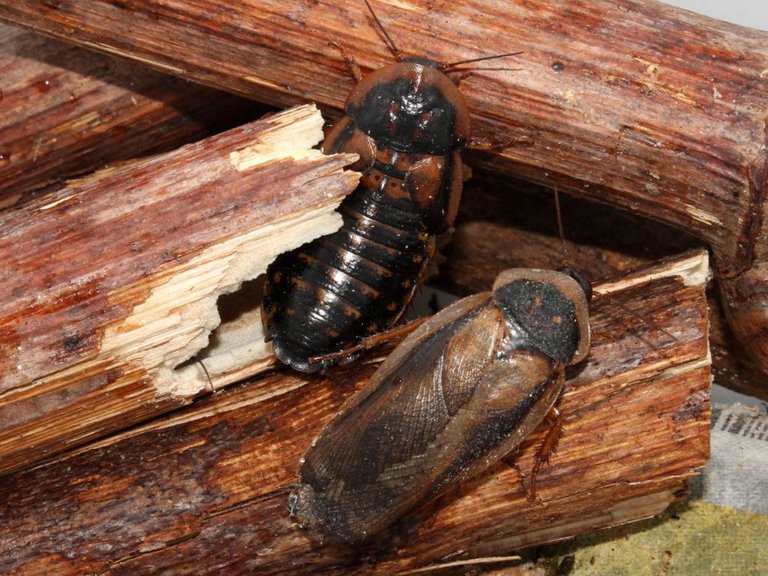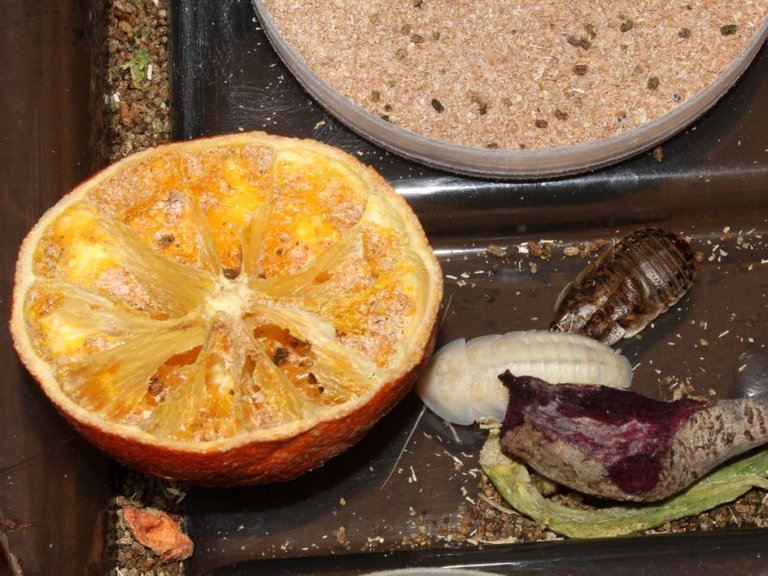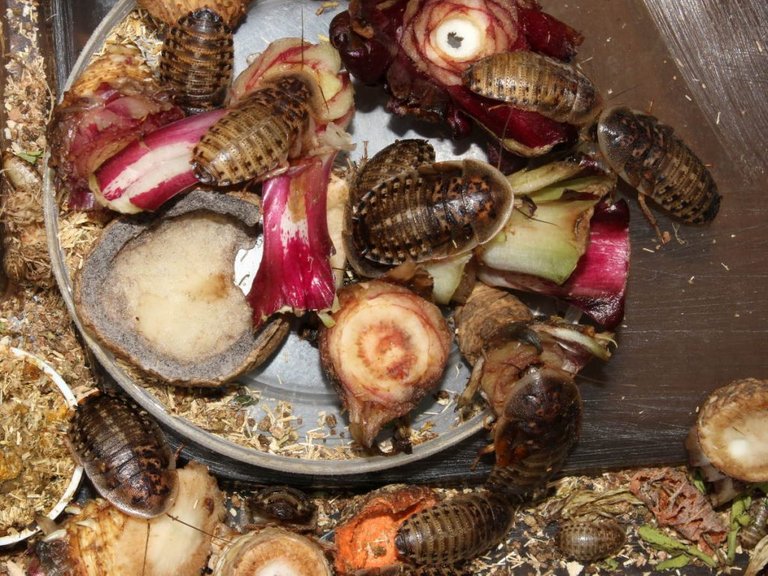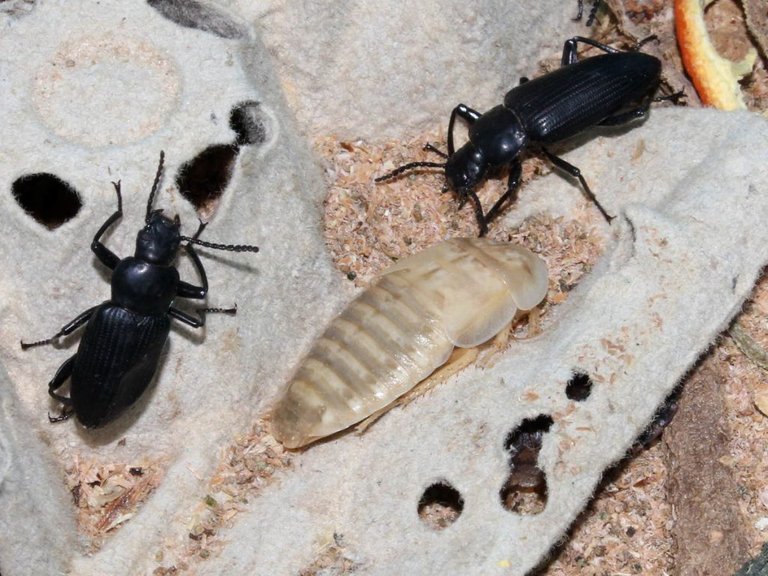NOT AS SCARY AS THEY SOUND
Dubia roaches are also called Orange-spotted roach, Guyana spotted roach and Argentinian wood roach. From their names alone it’s easy to tell a lot about their natural habitat, their geographic location and appearance.

Blauptica dubia roaches live in northern parts of South America. Since they live in tropical forests, they need high temperature and high air humidity to thrive. They don’t breed in temperatures lower than 20°C which makes it unlikely for them to infest a house, at least in a non-tropic environment.
Orange-spotted roaches grow up to 4.5 cm when adult. While male roaches have wings, females do not. Despite having wings, they are not the best flyers and usually only glide after they jump from an elevated position.
FEEDER ROACH
Due to the fact that they can’t fly, climb glass or smooth plastic surface, aren’t likely to infest your home and offer a protein rich source of nutrients for insect-eating animals, they became popular as reptile, tarantula, amphibian or scorpion feeder insects.
NON-FLYING FLYERS
As I mentioned before, males have fully developed wings, but are not known to fly around and don’t even have muscles that would allow them to become airborne. I thought they are not capable of flying until one day, I noticed how the little bugger somehow managed to get out of the closed breeder.
As the colony started to grow, the males became more and more active during the night. At one point, they started mating and fighting for their favorite jumping position on top of egg crate. I suspect that in heat of the night, they jumped ferociously and managed to skyrocket into the air and reach the breeder lid. Due to design flaw at that time, they could just walk over the fine mesh until they reached a small hole in the lid that wasn’t filled. I picked too fancy plastic container I guess.

Lucky for me, they are kind of loud when they stomp around or when they fly, which made them easy targets when I figured out they have a way out.
With time, males stopped their aggressive sexual behavior almost completely. There are two reasons for that. I caught quite a lot of males and removed them from the breeder. They didn’t need to fight for their ladies so they stopped. Second reason of their tranquility is, that their number got up considerably and they started crowding. It is strange and not really logical, but as the space gets crowded, they seem to stop fighting for their territory and just wander around peacefully.
Don’t trust them. They can surprise you and fly out of the breeder. Make sure you close it tight. Unless you like roaches roaming around the house. They should all be males, so there’s no way in heaven they could make baby roaches, but you never know in these modern days. 🙂

VORACIOUS EATERS
Dubia roaches love to eat oranges, they can devour orange in less than an hour. Same goes for carrots, lettuce or tomato. They also like to eat wheat bran or any kind of crushed grain. I don’t give them water gel as a source of water, instead, they receive fresh vegetables and fruit daily. I also refuse to offer them protein rich feed which can become harmful to the roaches in high amounts. They can easily get everything they need from other sources, they are roaches after all. Buggers even chew on their egg crates from time to time.

Dubia roaches don’t like less sweet things like potatoes, which are on the other hand preferred meal of mealworms and superworms. Strangely, people say that Dubia roaches like to eat protein rich food, I have noticed the opposite – they refuse to eat it and will nibble it for quite some time. Perhaps my roaches are strange, I think they just don’t need and like protein rich food and they rather pick carbohydrates.
BREEDING LIKE ROACHES
Roaches breed fast. Dubia roaches are not the fastest breeders, though. It takes from 3 to 4 months before the young nymphs reach maturity, there are other roaches that can have much faster cycle with larger numbers of nymphs they breed in one egg sac, also called ootheca. Female dubia roach keeps the ootheca inside her body until 20 to 40 young 2 mm long nymphs emerge. In case something goes wrong and the roachess get stressed, females can drop the egg capsule before the nymphs fully develop.
Considering the fact that the roaches become mature in 4 months and get their first brood in around 2 months, they need a lot of time to start, but when they do, their number starts increasing exponentially. Despite the slow start, they easily overcrowd their brooder in a matter of year or so.
LIFECYCLE OF DUBIA ROACH
Dubia roaches, like I mentioned earlier, emerge as a newborn nymphs. They then go through 7 instars – periods between molting, in which they grow and mature into an adult. During each instar, they add around 25% to their size. The duration of each instar depends a lot on temperature, feed they receive and possible stress inside the brooder.
After the nymph molts, it becomes large, completely white and soft. In short time it starts turning darker as the chitin starts to dry and harden a bit. Molting can be an issue for the nymphs, especially for male nymphs at their last instar before they turn to adult males. If the air is too dry, their exo-skeleton doesn’t get removed completely which can cause nymphs to die or appear deformed. If there are adult males with deformed wings, the cause usually lays in overly dry environment.
Adult dubia roaches can live up to over a year, sometimes even 2 years. If you keep the adults to breed new nymps, it’s generally good idea to replace the old roaches with younger insects on regular basis. That way, they don’t stop breeding, have more offspring and they don’t eventually die inside the brooder.
Hi! I am a robot. I just upvoted you! I found similar content that readers might be interested in:
https://cold-hardy.com/
My blog. I also wrote about the buggers there. :)